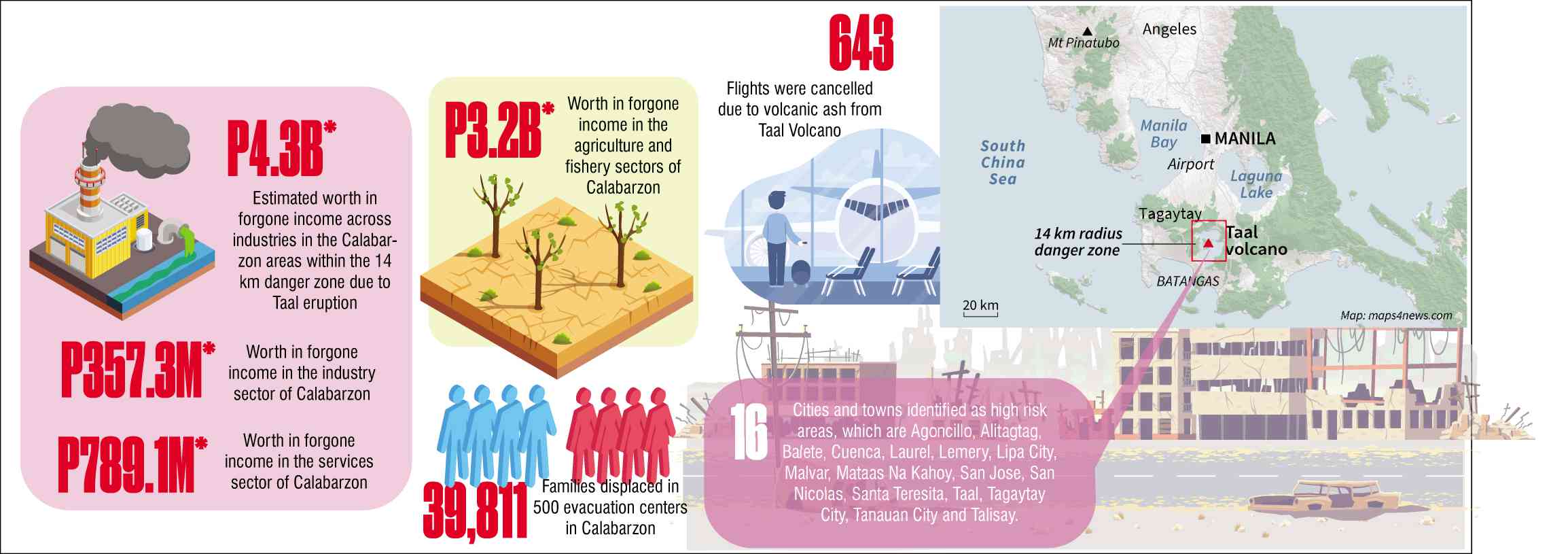Taal: In the heat of the moment

COMPILED BY RENZO MENDOZA AND LASMAR EDULLANTES, INQUIRER JUNIOR INTERNS SOURCES: DSWD, INQUIRER ARCHIVES AND NDRRMC
Taal Volcano island, some 2,475 hectares in area, has more than 40 craters, with its main crater responsible for major eruptions including the most recent one that caught many residents by surprise.
The Philippine Institute of Volcanology and Seismology (Phivolcs) has, in fact, monitored continuous signs of restiveness in Taal in recent years. Tourism activities on the volcano island were even restricted in March last year after Phivolcs raised alert level 1 for Taal Volcano after a series of quakes.
On Jan. 12, Taal showed an increase in volcanic activity, which led to a phreatic explosion from its main crater. A phreatic explosion occurs when magma hits ground or surface water, causing an explosion of water, steam, rock and ash.
The volcano spewed lava and massive ash column about 14 kilometers high, which rapidly spread and fell onto the immediate surrounding areas, reaching as far as Metro Manila.
Lava fountaining was also observed, generating ash plume, which drifted to the general southwest of the volcano while new fissures and cracks were reported in nearby towns in the aftermath of the eruption.
Phivolcs raised alert level 4, which means that hazardous explosive eruption is possible within hours to days. It remains in effect over Taal as of Jan. 23.
Since its earliest known activity in 1572, Taal Volcano has recorded more than 30 eruptions. The most disastrous eruptions were in 1754 and 1911.
The eruption in 1754, which lasted about seven months starting May 15, was identified as Plinian, an explosive gas-charged eruption, characterized by continuous and sustained ejection of pyroclasts, resulting in tall ash columns. It destroyed the old towns of Sala, Lipa, Tanauan and Talisay, and buried the old town of Taal, now the location of San Nicolas. Sala became a barangay of Tanauan. The capital was also moved from Taal to Batangas (now a city) in fear of next eruptions.
The people who perished in the 1754 eruption, the number undetermined, died either by getting buried under collapsing roofs or getting swept away by rushing waves or probably by drowning, an earlier Phivolcs study noted.
The 1911 Taal eruption was called phreatic, similar to what was seen earlier this month. The 1911 volcano eruption happened on Jan. 30, and had devastated almost the whole area of the volcano island—destroying 13 villages and killing 1,300 people.
Sources: Inquirer Archives, Phivolcs, batangas.gov.ph, tanauancity.gov.ph
